Artisan bread is a feast for the senses. If you’ve ever encountered a baker selling bread at the farmers market, or walked into a small artisan bakery, you know what I mean.
I’ve been buying fresh sourdough (a type of artisan bread) from small bakeries for a couple years now and would never go back to regular bread.
Today I want to explain the differences between artisan bread versus sourdough bread and regular grocery store bread. Plus, why you might want to choose one over the other.

I’ll also share about my journey from being gluten-free, to now being able to enjoy delicious sourdough bread without any of the issues that regular bread gave me.
And if you’d like to start baking your own bread from scratch, keep scrolling for some of my favorite artisan bread recipes.
Table of Contents:
- What is Artisan Bread?
- What is Sourdough Bread?
- Different Flours for Making Artisan Bread
- Reasons to Love Artisan Bread
- Sourdough Bread if You Are Gluten-Intolerant
- Artisan Bread Recipes
- FAQ: Artisan Bread
Let’s start with what is artisan bread anyway?
What is Artisan Bread?
The term artisan refers to a person in a skilled trade, usually one done by hand.
Potters are artisans, as are sculptors and people who make hand-made soap or candles.
Artisan bread is therefore any bread made by hand, by a bread-maker (the artisan).
Artisan bread is made in small batches using traditional bread making methods and simple ingredients.

The ingredient list on an artisan loaf is short:
- flour
- salt
- yeast
- warm water
Yep, that’s all you need to make bread!
Regular bread, the kind you find at the grocery store, is made in huge quantities with dough that was kneaded by machines.
The ingredient list on a loaf of regular bread is long. For example, the ingredient list to make Pepperidge Farm’s 100% Whole Wheat bread is:
- whole wheat flour
- water
- sugar
- cracked wheat
- yeast
- wheat gluten
- whey
- soybean oil
- sugarcane fiber
- salt
- calcium propionate
- sorbic acid
- datem
- monoglycerides
- natural flavor
- soy lecithin
Artisan bread does not contain preservatives. If you can’t eat the entire loaf within 2 or 3 days it’s necessary to freeze the rest so it doesn’t go stale.
Mass-produced bread contains preservatives, so it’ll last for a week or more before it starts to go bad. In the case of the Pepperidge Farm loaf that I mentioned above, calcium propionate and sorbic acid are the preservatives.
What is Sourdough Bread?
Sourdough is a type of artisan bread that doesn’t use commercial baker’s yeast to rise.
Instead of baker’s yeast, sourdough rises with the help of “sourdough starter”.
Sourdough starter is fermented flour and water that contains naturally-occurring wild yeast that leavens the bread.
The characteristic sour taste of sourdough bread comes from the lactic acid that’s created during the fermenting process. A quality loaf of artisan sourdough is full of air pockets that are created as CO2 is released while the dough ferments.
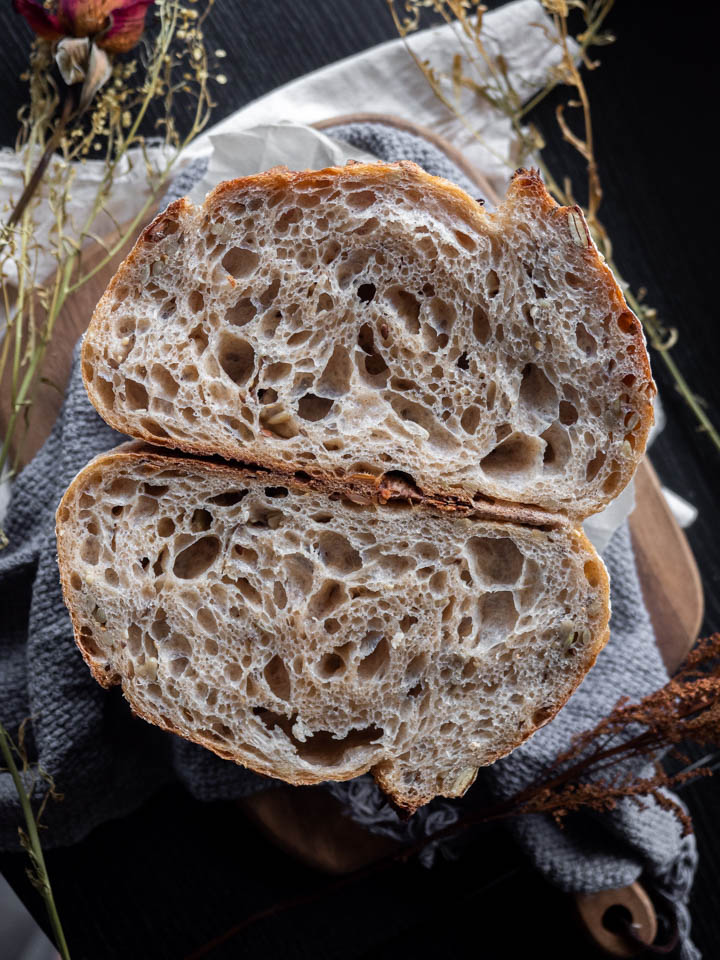
Sourdough isn’t a new invention. Bread-making relied on wild yeast for most of human history. Baker’s yeast was only invented in the last 150 years and popularized in the 1960’s.
What differentiates sourdough bread from other kinds of artisan bread is the use of wild yeast (created through the natural fermentation process), to leaven the bread.
If an artisan bread baker uses baker’s yeast to leaven the dough, their bread is not sourdough, it’s just regular artisan bread.
Like other artisan breads, the ingredient list to make sourdough bread is short and sweet:
- flour
- salt
- sourdough starter
- water
As you can see, sourdough bread uses sourdough starter instead of baker’s yeast. That’s the only difference when it comes to the ingredients.
Different Flours for Making Artisan Bread
Artisan bread (including sourdough) can be made with many different types of flour, there is not a specific “artisan bread flour”.
You could find artisan bread made with all purpose white flour, whole grain or whole wheat flour, organic flour and so on.
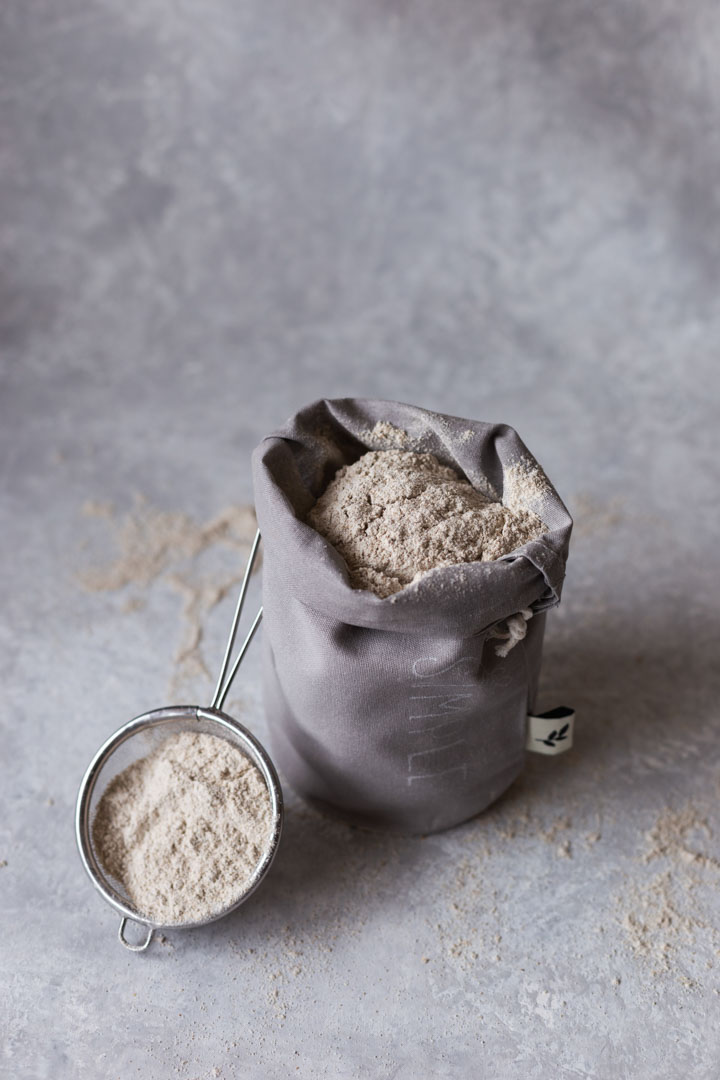
Here are a few of the more common types of flour used to make artisan bread.
All Purpose Flour
All purpose flour is the most popular type of flour used to bake bread. Regular white bread is made with all purpose flour and many artisan loaves are also made with all purpose flour.
All purpose flour is refined flour, meaning it’s made with only the endosperm of the wheat kernel…which is the least nutritious part.
Wait, white flour is made with the least nutritious part of wheat – how did that even become a thing?
Bread has a longer shelf-life when it’s made with only the endosperm. It’s also less healthy. When white flour first ‘became a thing’, people started getting sick. So white flour was fortified to add back in a little of what had been taken away.
Einkorn Flour
Einkorn is the oldest form of wheat known to man and is non-GMO. It was grown by farmers 5000 years ago! Einkorn flour is made by grinding the whole einkorn kernel and has more protein and essential fatty acids than modern whole wheat flour.
Einkorn flour also contains a different kind of gluten than modern flour…and less of it. For this reason, einkorn is easier for gluten-intolerant people to digest.
If you plan to bake bread with einkorn flour, be sure to use a recipe made for it, like this one. Einkorn flour doesn’t substitute well for regular flour.
Einkorn also has a distinct flavor, different from regular wheat flour. So don’t blame the baker if you don’t like this type of bread.
Hand-milled flour
Last week I met a lady selling bread at the farmers market who used flour she milled by hand. I was curious about this and we had an interesting conversation.
In short, hand-milled flour is made by grinding your own wheat berries. If someone makes bread with hand-milled flour that means they literally ground their own flour.
Hand-milled flour is made from the whole wheat kernel (aka the wheat berry) and is far more nutritious than regular white flour.
Organic Flour
Organic flour is made by milling organic, non-GMO wheat that was grown without the use of chemical pesticides or fertilizers. Organic flour is also never bleached or bromated.
Traditionally, freshly-milled flour was left to age and be exposed to oxygen for a couple months. But of course, we don’t have time for that now. The process of bleaching flour achieves similar results in much less time…making the flour whiter and finer in texture.
Bromate is a dough conditioner. Dough conditioners strengthen flour, improving its elasticity when you make dough.
Rye Flour
I recently had a loaf of rye sourdough for the first time, and it was divine. Rye flour is made by milling rye grains, which are different from regular wheat grains.
Rye bread is darker in color than regular wheat bread and has a more dense texture.
That said, my sourdough rye was anything but dense. It was full of beautiful air pockets that were created as CO2 is released during the sourdough fermentation process.
Stone Ground Flour
Stone ground flour (aka stone milled flour) is whole grain flour produced the traditional way by grinding the grain between two millstones.
It’s thought that more of the wheat germ is left in tact compared to more modern ways of grinding flour.
Stone-ground flour will have a less fine texture than regular whole wheat flour. Nutritionally they should be the same.
Whole Grain Flour
Whole grain flour is milled from the whole wheat kernel. It’s a complete form of modern wheat flour and is healthier than white flour. See this diagram of a wheat kernel.
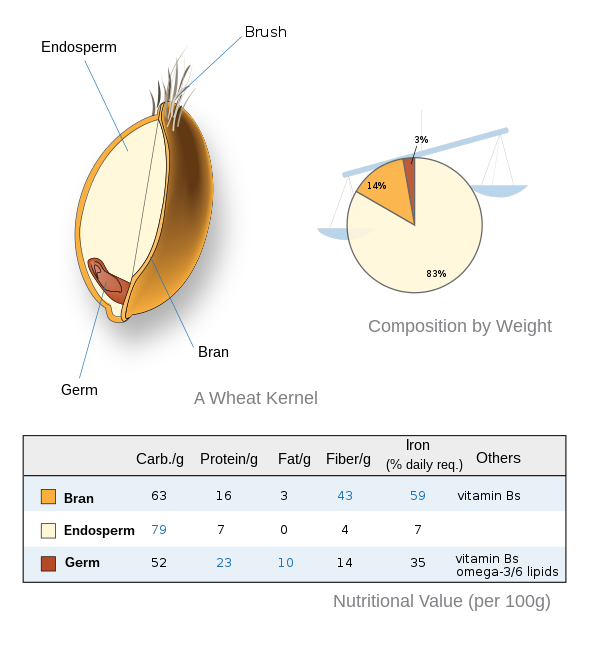
According to researchers at Harvard, eating whole grains instead of refined grains (white flour) substantially lowers total cholesterol, LDL (or bad) cholesterol, triglycerides, and insulin levels.
The researchers also point out that the fiber, nutrients, and phytochemicals in whole grain bread may slow the absorption of food, preventing blood sugar spikes. Whole grains have a lower glycemic index than refined grains used to make white flour.
Reasons to Love Artisan Bread
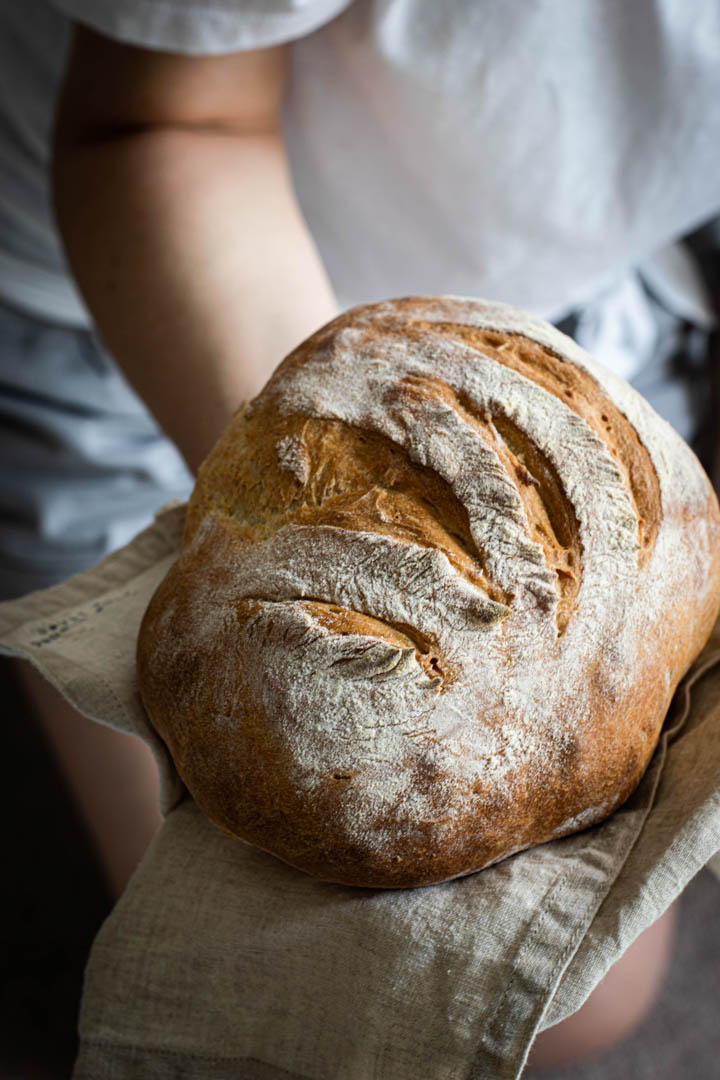
There are lots of reasons to chose artisan bread over mass-produced bread from the grocery store.
No preservatives – A true artisan bread is made with natural ingredients and no preservatives.
No synthetic flavors – Artisan bread should never contain added flavors, regardless of whether they are artificial or “natural”. Any flavor should come from actual food ingredients. For example, an artisan parmesan ciabatta bread is baked with real parmesan.
Quality ingredients – Artisan bread bakers take pride in what they make, this is not just about increasing profit and extending shelf-life. Artisan bakers are passionate and, in my experience, appreciate the value of using high-quality ingredients when they bake bread.
No inflammatory oils – I read the ingredient list of 5 different brands of commercial whole wheat bread for this article and they ALL contained soybean oil. You will not find an artisan bread recipe that uses soybean oil, or any other inflammatory oil. And if you do…find another recipe. I’m sharing some below.
No sugar – Unless you’re baking a sweet bread, a regular loaf of bread does not need sugar. No artisan baker worth their weight in salt would willy nilly throw sugar into a loaf of bread. But commercial bread bakers do this all the time. All 5 loaves whose ingredient labels I read contained sugar!
Support small producers – Buying bread from small, local bakers is a delicious way to support local and feel more connected to the food you eat.
Sourdough Bread if You Are Gluten-Intolerant
A couple years ago, after a decade of not eating gluten because it gave me agonizing stomach pain, I discovered long-fermented sourdough bread.
It was while listening to a podcast episode by Kristin over at Live Simply. She talked about how she had a gluten-sensitivity and was able to enjoy sourdough bread without issue.
At the time I listened to the episode I had never tried sourdough, but boy was a nice slice of bread something I missed!
So I did some research and found evidence to back up her anecdotal story.
What I learned is that up until the last 100 years or so, all bread was sourdough bread.
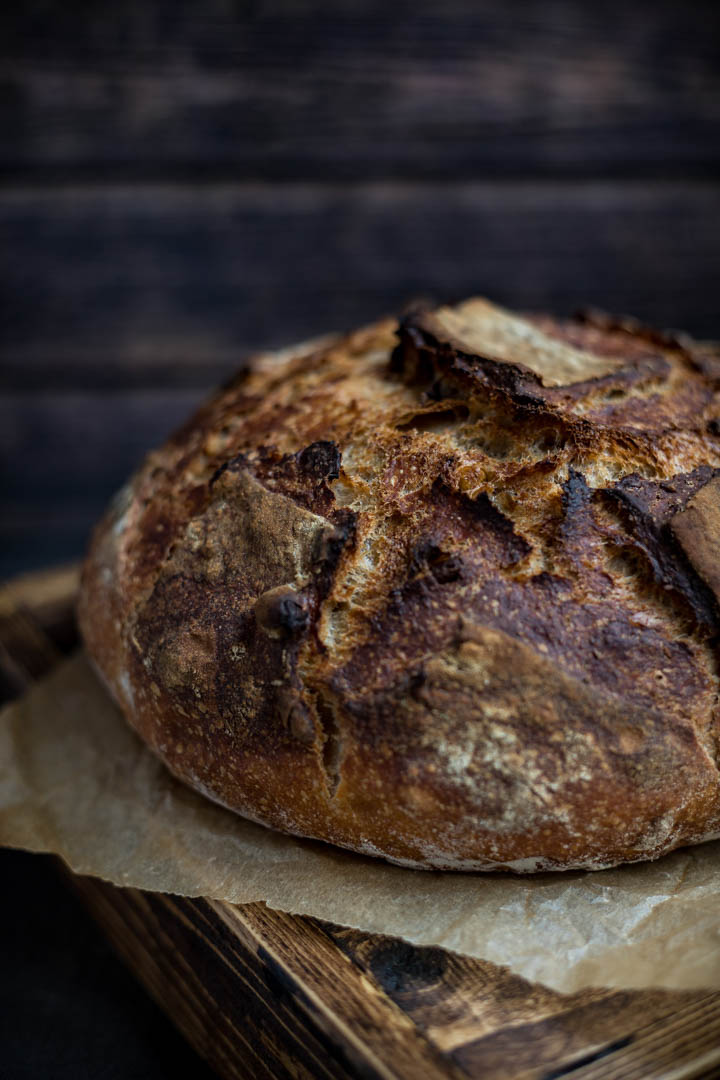
Our ancestors have used a natural fermentation process to leaven bread for thousands of years. Then baker’s yeast was invented and that changed. A long-fermentation process was no longer necessary, bread bakers could use store-bought yeast to leaven their bread.
But the fermentation of wheat was key to making it easier for humans to digest. Cows have special stomachs for breaking down grasses, humans do not.
The fermentation of wheat was key to making it easier for humans to digest.
I decided to buy a loaf of artisan sourdough at the farmers market and see how my body reacted. I’ve never looked back.
I discovered that I can eat long-fermented sourdough bread, and other sourdough baked goods without painful consequence. I don’t want to push my luck though, and am careful to enjoy in moderation!
What does long-fermented sourdough mean?
While there is no specific definition of “long-fermented”, my research at the time led me to conclude that I should be looking for sourdough that was fermented for at least 12 hours and at minimum 8 hours.
I’ve found artisan sourdough bakers that long-ferment their sourdough for 36 hours! The longer the better.
Before trying sourdough bread from a different baker I always ask:
- “For how many hours do you ferment your dough?” And I want to hear at least 8 hours.
- “Do you use commercial baker’s yeast?” They should say “no” and I clarify asking if they use a sourdough starter to leaven their dough.
Artisan Bread Recipes
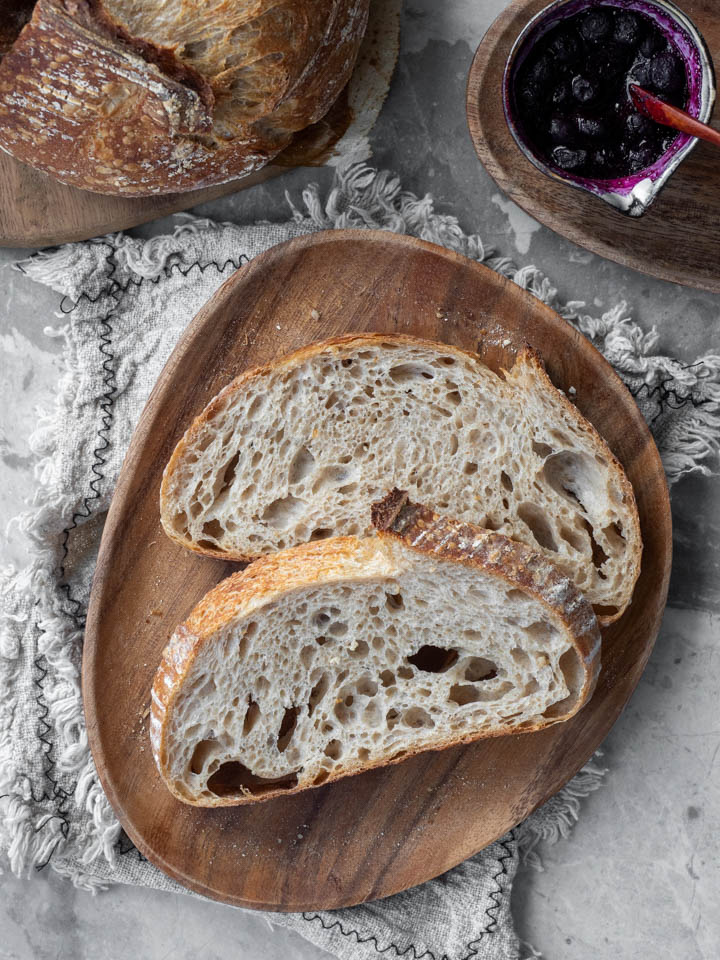
I’ve curated a good selection of recipes here for anyone new to baking homemade bread. I’ve got a few sourdough recipes, some regular artisan bread recipes and gluten-free artisan bread recipes.
Sourdough Recipes
If you’re interested in learning how to make homemade sourdough bread you should first know that it’s a bit of a commitment.
Unlike other artisan breads that you can make with store-bought baker’s yeast, sourdough bread requires making and maintaining (aka “feeding”) your own sourdough starter.
That said, if you know a sourdough baker they would probably be happy to give you a little of their starter so you can start baking.
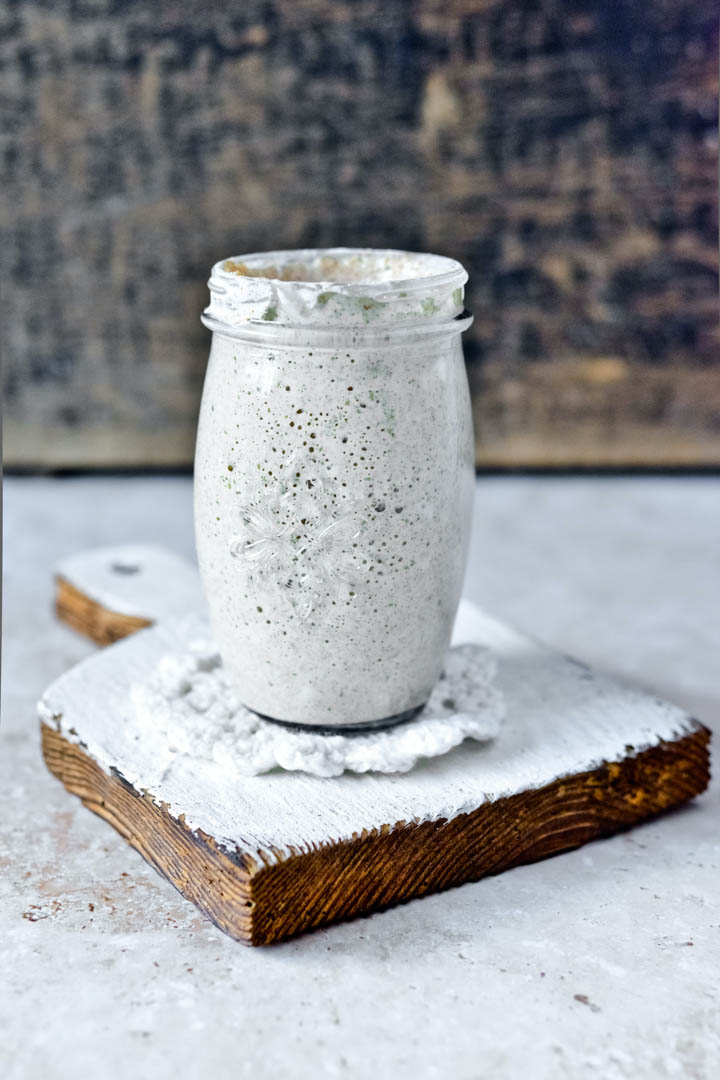
Two of my favorite sourdough bakers to follow for lots of sourdough baking tips are Lisa at Farmhouse on Boone and Maurizio at The Perfect Loaf.
Here are a few sourdough bread recipes and tips to get you started:
- How to Make a Sourdough Starter
- How to Feed Your Sourdough Starter
- Beginner’s Sourdough Bread Recipe
- Artisan Sourdough Boule
- Easy No-Knead Sourdough Bread
Artisan Bread Recipes
These artisan bread recipes will have you baking homemade bread today if you have the ingredients on hand.

A nice thing about making regular homemade bread rather than sourdough, is you don’t need to maintain a sourdough starter, just buy baker’s yeast at the grocery store.
One thing to be aware of that could throw off your loaves of homemade bread is the altitude you live at. Bread rises faster and easier at high altitude (ex. Colorado) than it does at low altitudes (ex. Florida).
Here are some homemade bread recipes to get you started.
- High Altitude Crusty French Bread
- Homemade Bread (with or without a dutch oven)
- Homemade Artisan Bread (4 Ingredients)
Gluten-Free Artisan Bread Recipes
Want to make homemade bread but you’re gluten-free? No problem, you can still make homemade gluten-free bread.
The trick is that gluten-free dough doesn’t hold together as well or rise as much as regular wheat dough. So it’s important to follow a gluten-free bread recipe, rather than a regular bread recipe. Even if you make it with gluten-free flour.
- The Ultimate Gluten-Free Bread Recipe (Vegan too)
- Gluten-Free Artisan Baguettes
- Gluten-Free Seeded Loaf
FAQ: Artisan Bread
Where can I buy artisan bread?
I recommend buying artisan bread directly from a baker who is selling at the farmers market or at a small artisan bakery in your town.
Run an online search for “artisan bread” or “artisan bakery” to find a bakery near you.
To give you an example, here are a couple artisan bakers I know of:
- Underground Baking in Hendersonville, NC
- Hominy Farm in Asheville, NC
How to store artisan bread
A loaf of artisan bread should be stored on your counter at room temperature. If the bread comes in a plastic bag, leave it inside the bag on your counter.
If it didn’t come in a bag, or came in a paper bag, a baker I know recommends wrapping it in a dish towel on your counter instead.
The dish towel will help keep it from drying out, especially once you cut into it. My baker friend advised not to put artisan bread in the fridge, which will accelerate the how quickly it goes stale.
Because artisan bread is made without preservatives it does not last long. After two days I move my sliced bread to the freezer and take out pieces of it as needed.
What about sourdough bread at the grocery store?
In my experience grocery stores do not sell true sourdough bread. Frankly it’s not feasible…maintaining that sensitive sourdough starter, the time to let the dough rise, kneading by hand.
Time and time again I’ve talked to the people working at the bakery department in even small, quaint little grocery stores to ask about their sourdough and found it’s not the real thing.
Keep reading to find out how I recognize real sourdough bread.
How to recognize real sourdough bread
Real sourdough bread does not contain baker’s yeast or any kind of commercial yeast in the ingredient list. If a loaf of bread is labeled as “sourdough” and the ingredient list contains “yeast”, you’re being sold a fake product. It’s as simple as that.
If wild sourdough starter isn’t THE ONLY thing they use to leaven their bread they are taking short cuts and most consumers are buying it (literally and figuratively).
This is why I only buy artisan sourdough bread made without commercial yeast.
If a loaf of bread is labeled as “sourdough” and the ingredient list contains “yeast”, you’re being sold a fake product. It’s as simple as that.

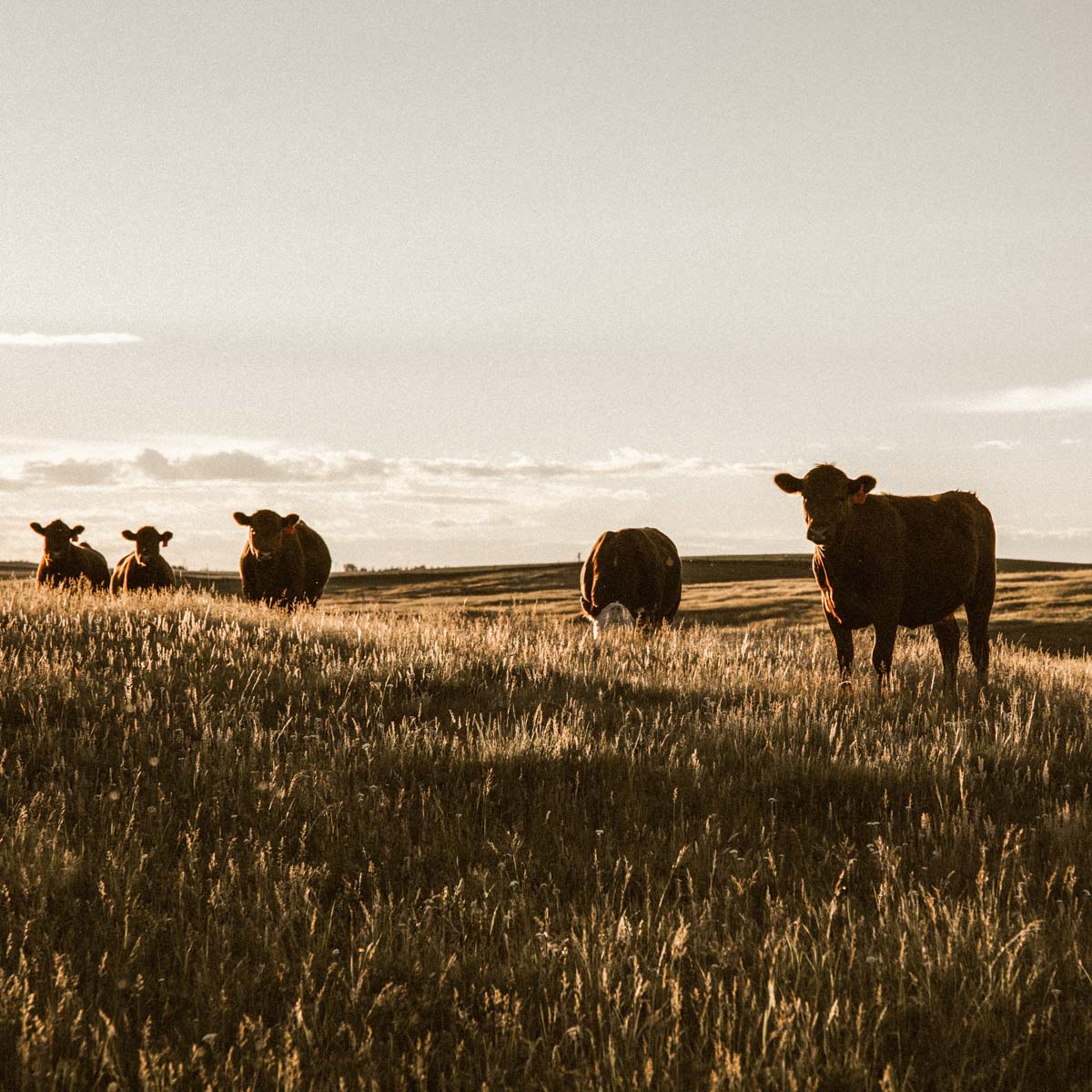
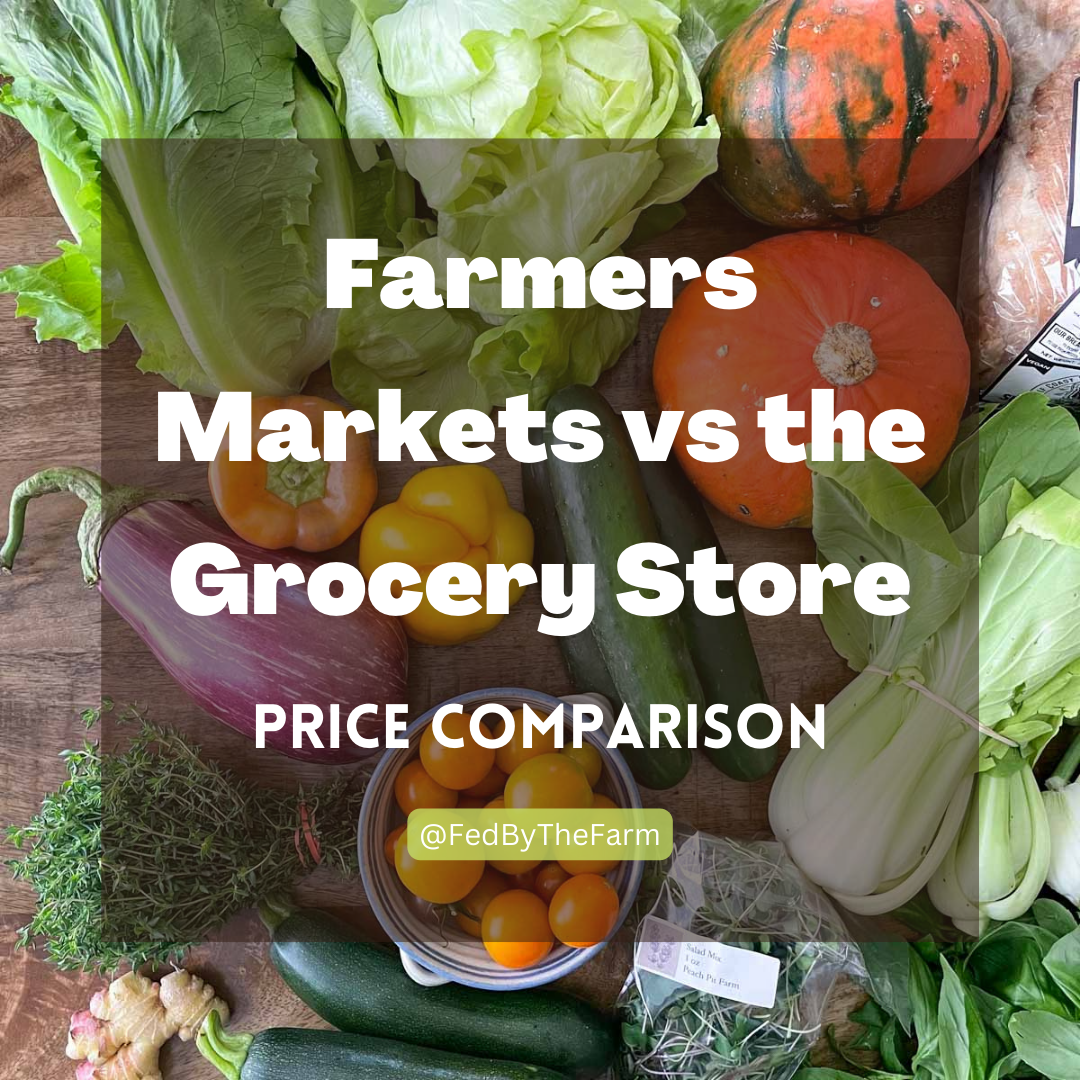
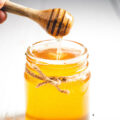


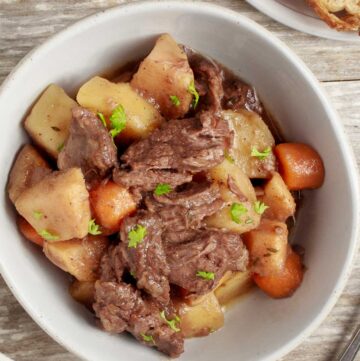

Enjoyed this article , especially the part about altitude and the difference it makes in rising the dough. I thought my son wasn’t being accurate when he said his Colorado sourdough rose in about 4 hours .when out there I made a loaf and sure enough he was right. Mine rises overnight and then some in Minnesota.
Thank you for sharing Patricia. Happy to hear you found that nugget informative. 🙂